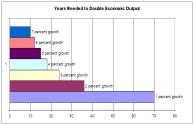When I give speeches about public policy issues, people sometimes ask about the impact of various policies on economic growth.
- What will happen to growth if the death tax is repealed?
- How much will GDP be hurt by Trump’s protectionism?
- If HUD is abolished, will there be a growth dividend?
I always respond with a giant caveat about economists being lousy forecasters, and I also warn that there are many policies that determine prosperity, which makes it inherently difficult to estimate the impact of one policy.
But when pressed, I’ll toss out a number – say 2/10ths of 1 percent. And that type of answer almost always seems to disappoint the audience. It’s as if there’s a collective assessment that we shouldn’t waste time fighting for or against certain policies if the impact on growth is so trivially small.
And if you’re planning on dying in the next six months, then maybe it isn’t worth it.
In reality, though, even small differences in growth can make a big difference to prosperity if they can be sustained. This chart, which starts with the Commerce Department’s estimate of GDP for 2017 and is then adjusted for the Census Bureau’s population projections, shows how a “trivial” increase in the growth rate over the next 25 years winds up generating big increases in per-capita GDP.
Maybe I’m not a big and bold thinker, but this kind of improvement is worth fighting for.
Back in 2014, I tried to make this same point  with a chart showing how long it takes an economy to double in size based on different growth rates.
with a chart showing how long it takes an economy to double in size based on different growth rates.
It seems obvious that it’s better to be at the top of that chart, like Hong Kong and Singapore, instead of the bottom, like Italy or Greece.
And Veronique de Rugy, in a column for National Review, shared a more sophisticated version of the chart. At the risk of stating the obvious, you want the big circles to happen faster.
Let’s share one more chart, and I put it together because I’m sometimes asked about the potential impact on growth if all libertarian policies were adopted?
Once again, I give a standard caveat about economists and forecasting. And I also explain the principle of convergence so the audience understands it’s more difficult for a rich country to achieve very high growth rates.
But eventually I’ll speculate that an ideal set of policies might increase growth by 1 percent annually.
Which, once again, doesn’t seem to impress people.
In the future, though, I’m going to share this chart, showing historical numbers for U.S. and Mexican per-capita GDP from the Maddison database, augmented by a second (yellow) line showing where America would be if per-capita GDP increased by one-percentage point less each year.
In other words, an additional percentage point of growth may not sound amazingly impressive, but over time it generates amazingly impressive outcomes.
The bottom line is that even trivial pro-growth reforms are worth the effort. Even if it takes a few years for the growth to materialize or if the growth only lasts for a limited period of time.


